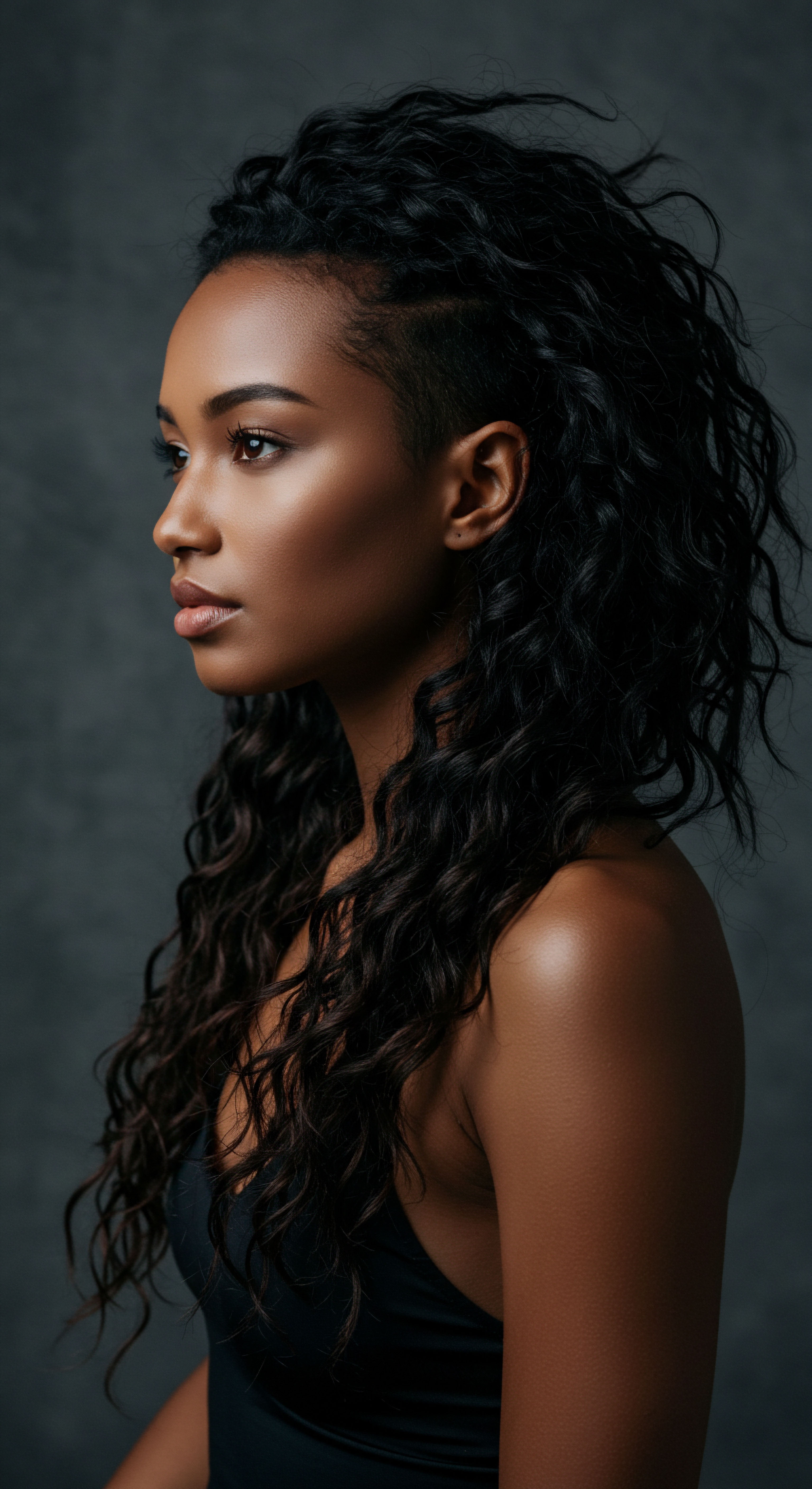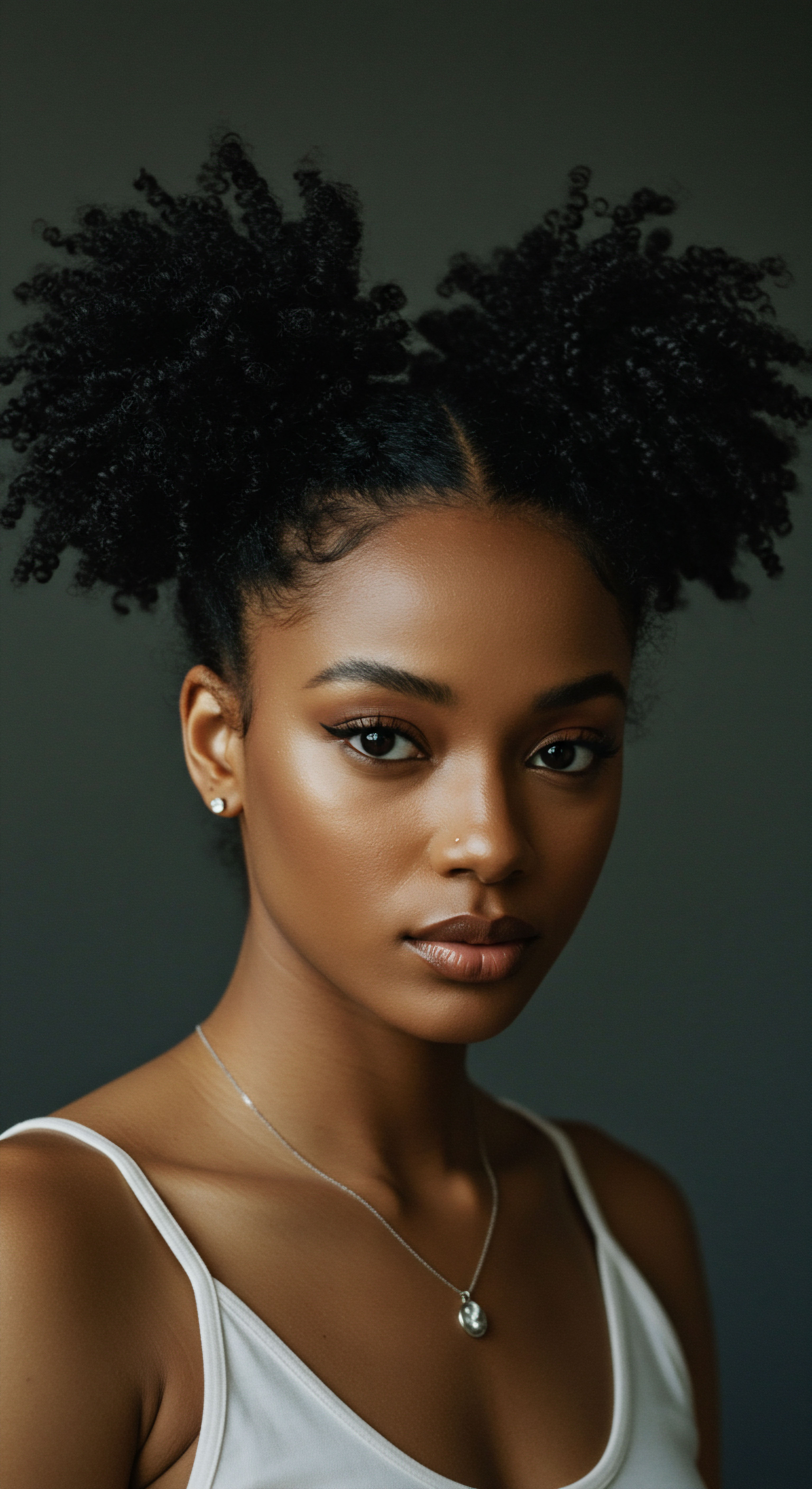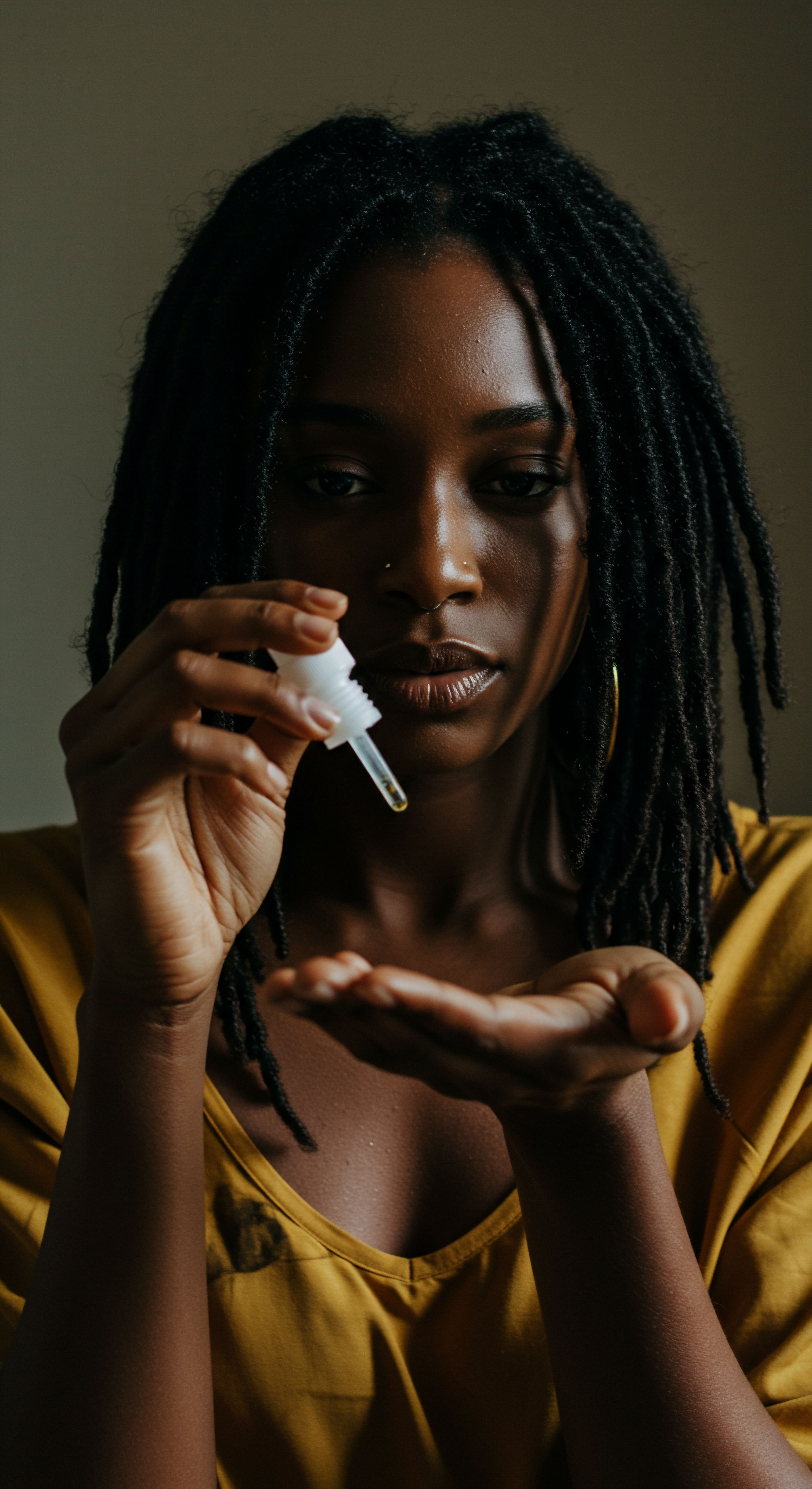
Fundamentals
The concept of Black Children Identity, when viewed through the gentle, discerning lens of Roothea, begins not as a simple definition, but as a tender bloom, unfolding within the rich soil of heritage and lived experience. At its most fundamental, this identity represents the profound understanding a Black child develops about who they are in the world, recognizing their unique place within the expansive tapestry of Black cultures, histories, and communities. It is a deeply personal revelation, a growing awareness of self that is inextricably linked to their racial and ethnic background. This initial recognition extends beyond mere physical appearance; it encompasses the spirit, the resilience, and the joy that have long defined Black people.
For our youngest, this burgeoning sense of self often first takes root in the tactile world of their hair. Textured hair, in its magnificent coils, curls, and kinks, serves as an early, tangible touchstone of identity. It is a visible marker, a crown that distinguishes and connects them to a shared lineage. The gentle hands of a caregiver tending to coils, the patient detangling, the rhythmic braiding, all communicate messages of belonging and care.
These rituals are not simply about neatness; they are quiet lessons in self-acceptance, in the beauty of what grows naturally from one’s scalp. They lay a foundational understanding that one’s hair, in its unadulterated form, is beautiful, deserving of adoration and thoughtful care.

Early Expressions of Self-Recognition
Children begin to perceive differences and similarities in their environment from a very early age. For Black children, this includes recognizing their own skin tone and hair texture, and how these attributes connect them to family members and their broader community. This recognition forms the bedrock of their identity, influencing how they see themselves and interact with the world.
- Self-Perception ❉ A child’s initial grasp of their physical appearance, particularly their hair and skin, as distinct and meaningful.
- Family Connection ❉ The recognition of shared physical traits and cultural practices with immediate and extended family members.
- Cultural Awareness ❉ The nascent understanding that their family’s traditions, stories, and expressions are part of a larger, vibrant cultural heritage.
This initial phase is delicate, much like the first tender shoots of a seedling. It is a period where positive affirmation acts as nourishing sunlight, encouraging healthy growth. When a child hears their hair described with terms of beauty and strength, when they see themselves reflected positively in stories and images, it fortifies this nascent identity. The simplest acts, like admiring a child’s cornrows or celebrating the bounce of their coils, become powerful affirmations.
Black Children Identity, at its simplest, is the blossoming self-awareness a child gains from recognizing their inherent connection to Black heritage and the distinctive beauty of their textured hair.

The Role of Hair in Early Identity Formation
Hair, especially textured hair, possesses a unique significance in the early stages of a Black child’s identity development. It is a dynamic canvas, capable of endless styles and expressions, yet also a biological marker of ancestry. The very act of caring for textured hair often involves specific tools, techniques, and products, creating a ritual that can be passed down through generations. This ritual serves as a profound bonding experience, a moment of intimate connection between child and caregiver, where cultural knowledge and affection are shared.
Consider the simple joy of a child feeling the softness of their freshly washed coils, or the pride in a new set of braids. These moments, seemingly small, build a reservoir of positive self-regard. They contribute to a child’s internal narrative, shaping their understanding of their own worth and beauty. Without these affirming experiences, the tender shoots of identity can face challenging winds, making the foundation less stable.

Intermediate
Moving beyond the foundational elements, the intermediate understanding of Black Children Identity delves into the active shaping and negotiation of this self-perception within broader societal contexts. Here, the meaning of Black Children Identity expands to encompass the dynamic interplay between personal discovery and external perceptions, particularly as children begin to navigate environments beyond the immediate family circle. It becomes a more complex elucidation, influenced by interactions at school, within media, and among peers. The gentle wisdom of Roothea suggests that this phase is akin to a plant reaching for the sun, its roots deepening while its branches stretch, sometimes encountering unexpected resistance.
In this stage, the significance of textured hair becomes more pronounced, often serving as a focal point for both affirmation and challenge. Children become more aware of how their hair is viewed by others, not just those who share their background, but also those who do not. This can manifest in subtle questions, curious glances, or, regrettably, overt acts of discrimination. The resilience of the child’s identity begins to be tested, requiring internal strength and external support.

Navigating Societal Perceptions
As Black children grow, their awareness of societal beauty standards and racial biases heightens. This can introduce a tension between the positive self-image cultivated at home and the often Eurocentric ideals prevalent in mainstream society. The concept of “good hair” versus “bad hair,” a painful legacy of historical oppression, can subtly or overtly influence a child’s self-esteem.
The intermediate understanding of Black Children Identity involves navigating external perceptions and biases, where textured hair often becomes a central point of societal interaction.
The impact of this external gaze is not merely theoretical. Research illuminates the tangible harm experienced by Black children due to hair discrimination. For instance, a 2021 study revealed that 66% of Black children in majority-white schools reported experiencing race-based hair discrimination, with a staggering 86% of those children facing it by the age of 12. Moreover, 100% of Black elementary school girls in majority-white schools who reported hair discrimination had experienced it by the age of 10.
This data point, while stark, underscores the pervasive nature of this particular challenge, highlighting how deeply ingrained biases can affect a child’s sense of self and belonging from a very young age. This is not merely about aesthetic preference; it represents a profound systemic issue where a child’s natural physical attributes are deemed “unprofessional” or “distracting,” leading to disciplinary actions and psychological distress.
Such experiences can lead to internal conflict, where children may begin to wish their hair was different, despite previously holding a positive view of it. The same 2021 study by Dove found that despite 90% of Black children stating their hair is beautiful, 81% of Black children in majority-white schools sometimes wished their hair was straight. This statistic paints a vivid picture of the silent struggle many young Black individuals endure, a poignant reflection of how external pressures can erode internal affirmations.

Cultural Socialization and Hair Care Rituals
In response to these external pressures, cultural socialization becomes increasingly significant. This involves the deliberate passing down of cultural knowledge, values, and practices, including specific hair care routines. These routines become more than just practical necessities; they are acts of cultural preservation and resistance.
- Skill Transmission ❉ Learning the techniques for detangling, braiding, twisting, and moisturizing textured hair, which are often distinct from care routines for other hair types.
- Historical Context ❉ Understanding the historical and cultural significance of various Black hairstyles, connecting present practices to ancestral traditions.
- Community Building ❉ Participating in shared hair experiences within family and community, reinforcing a sense of collective identity and belonging.
The communal aspects of hair care, whether it is a parent doing their child’s hair, or children learning from older relatives, serve as vital spaces for reinforcing positive identity messages. These moments can counteract negative societal messages, providing a grounding presence amidst a world that may not always understand or celebrate their unique beauty. The wisdom passed down through these rituals instills a sense of pride and continuity, offering children a powerful tool for self-affirmation.

Advanced
The advanced explication of Black Children Identity transcends superficial observation, delving into its intricate construction as a dynamic, multifaceted phenomenon. This comprehensive interpretation acknowledges the profound interplay of biological inheritance, socio-historical forces, psychological development, and cultural agency, all profoundly manifest within the unique context of textured hair. For Roothea, this signifies a deep, scholarly understanding, akin to discerning the complex botanical processes that allow a rare orchid to flourish in specific, challenging conditions. It is a delineation that moves beyond simple recognition, instead offering a sophisticated analysis of how identity is forged amidst both affirmation and adversity, particularly for Black children and their textured hair.
The significance of Black Children Identity, at this advanced level, lies in its capacity to illuminate systemic inequities while simultaneously celebrating the enduring spirit of self-determination. It is a critical lens through which to comprehend the long-term consequences of racialized experiences on psychological well-being, academic trajectory, and social integration. This understanding provides maximum insight for experts, researchers, and policymakers, revealing how seemingly individual experiences are, in fact, reflections of broader societal structures.

Intersectional Frameworks of Identity Construction
At its core, Black Children Identity represents the developmental trajectory of a child of African descent in constructing a coherent sense of self, where racial and ethnic consciousness are not mere components but foundational pillars. This construction is inherently intersectional, meaning it cannot be fully comprehended without considering how race interacts with gender, socioeconomic status, geographical location, and indeed, hair texture. The biological reality of highly coiled, tightly curled, or intricately patterned hair becomes a nexus where historical subjugation, cultural resilience, and personal expression converge.
From a theoretical perspective, this identity is not passively received but actively negotiated. Children engage in a continuous process of interpreting messages about Blackness from their families, communities, and the wider world. When these messages are contradictory—for instance, familial celebration of natural hair contrasting with school policies that penalize it—the child must reconcile these dissonances. This reconciliation process shapes their internal working models of self and belonging.
The “Hair Equality Report 2019” by World Afro Day revealed that one in six children with Afro-textured hair reported a “bad or very bad experience” with their hair and identity within the school system. This stark reality showcases the profound impact of institutional environments on a child’s developing self-perception, transforming a biological trait into a site of struggle.
This sophisticated perspective recognizes that hair, for Black children, is rarely just a cosmetic choice. It is a potent symbol, often politicized, and its acceptance or rejection by institutions can have tangible consequences. The persistent devaluation of natural hair acts as a proxy for the devaluation of Black identity itself, deeply intertwining the two.
Black Children Identity, at an advanced conceptualization, unveils the dynamic interplay of biological heritage, socio-historical forces, and individual agency in shaping a child’s self-perception, particularly as expressed through textured hair.

Psychosocial Ramifications of Hair-Based Discrimination
The impact of hair discrimination on Black children extends far beyond mere discomfort; it imposes significant psychosocial burdens. When a child’s natural hair is deemed “unprofessional,” “unruly,” or “distracting” by educators or peers, it communicates a powerful, damaging message ❉ their inherent being is unacceptable. This experience, often termed “esthetic trauma,” contributes to negative self-image, anxiety, and chronic stress. The constant vigilance required to navigate spaces where their hair might be scrutinized or disciplined leads to a state of hypervigilance, diverting cognitive and emotional resources away from learning and social engagement.
Consider the case of Darryl George, a Black high school student in Texas, who was unlawfully denied access to public education due to the length of his locs. This highly publicized instance is not an isolated event but a stark illustration of how systemic biases, cloaked in ostensibly neutral dress codes, disproportionately affect Black students. Such policies, often reflecting Eurocentric beauty standards, force Black children to choose between their authentic selves and their right to an education, or to conform to standards that require altering their natural hair, sometimes through physically and psychologically damaging chemical processes. The long-term consequences of such experiences can include internalized racism, cultural disconnection, and diminished self-esteem, affecting their confidence and well-being throughout their lives.
Furthermore, research indicates that Black children are three to six times more likely to be suspended from school through discretionary school suspensions, with educators sometimes citing a need to “prepare them for the real world.” This disciplinary disparity, often linked to hair policies, funnels Black students into the school-to-prison pipeline, a severe long-term consequence. The profound societal implications call for a deeper examination of how such policies perpetuate cycles of inequity, impacting not only individual children but also the collective advancement of Black communities.

The Science of Textured Hair and Identity
From a scientific standpoint, understanding Black Children Identity also necessitates a nuanced comprehension of textured hair’s unique structural properties and care requirements. The tightly coiled helix of Afro-textured hair, for instance, possesses a distinct elasticity and porosity profile compared to straighter hair types. This structural difference means it requires specific moisture retention strategies and gentle handling to prevent breakage.
| Hair Property Coil Pattern |
| Scientific Explanation Elliptical hair shaft, creating tight curls or kinks, which influences how light reflects and how oils travel down the strand. |
| Identity Connection A visual marker of racial identity; a source of pride and unique aesthetic expression. |
| Hair Property Porosity |
| Scientific Explanation The hair's ability to absorb and retain moisture, often higher in textured hair due to lifted cuticles, making it prone to dryness. |
| Identity Connection Necessitates specific care routines, fostering a deeper connection to hair health and self-care practices. |
| Hair Property Density & Volume |
| Scientific Explanation The number of hair strands per square inch, often appearing voluminous due to its outward growth pattern. |
| Identity Connection Contributes to distinctive silhouettes and styles, embodying cultural aesthetics and natural abundance. |
| Hair Property Understanding these properties informs effective care and reinforces a positive relationship with one's natural hair. |
Ignoring these scientific realities, as many Eurocentric hair care norms often do, leads to inappropriate product recommendations and damaging practices. When a child’s hair is misunderstood or mistreated due to a lack of knowledge, it can lead to physical damage, discomfort, and, by extension, negative feelings about their hair and themselves. This scientific understanding, therefore, becomes an integral part of affirming Black Children Identity, empowering individuals with the knowledge to properly care for their unique hair and reject harmful external standards. This expert-driven insight offers a pathway to long-term hair health and, concurrently, a strengthened sense of self.

Reflection
As we gently close this exploration of Black Children Identity, particularly through the prism of textured hair, we find ourselves contemplating a landscape rich with heritage, resilience, and profound beauty. The journey from nascent self-recognition to a sophisticated understanding of societal and scientific interplay reveals that this identity is not static; it is a living, breathing entity, shaped by countless interactions and internal dialogues. The delicate coils and vibrant patterns of Black children’s hair serve as a powerful testament to a lineage of strength, adaptability, and boundless creativity.
Roothea envisions a future where every child with textured hair experiences a world that celebrates their unique crowning glory, free from the shadow of bias or misunderstanding. This vision extends beyond mere tolerance, reaching for a profound appreciation that recognizes the cultural depth, the scientific marvel, and the personal joy inherent in Black hair. It is a call to cultivate environments where curiosity replaces judgment, where knowledge dispels ignorance, and where the inherent dignity of every child is affirmed without reservation.
The true measure of our collective progress lies in how well we nurture the tender spirits of our youngest, ensuring they grow into individuals who not only know their worth but also embody it with quiet confidence and radiant pride. The ongoing dialogue surrounding Black Children Identity, rooted deeply in the realities of their hair experiences, continues to guide us toward a more inclusive and understanding world, one strand at a time.

References
- Abrams, L. S. Belgrave, F. Z. Williams, A. B. & Maxwell, M. (2020). The development of a self-esteem toolkit for Black adolescent girls centering hair as a tool for empowerment. EliScholar – A Digital Platform for Scholarly Publishing at Yale.
- Byrd, A. D. & Tharps, L. D. (2001). Hair Story ❉ Untangling the Roots of Black Hair in America. St. Martin’s Press.
- Cave, A. et al. (2020). Racial discrimination and mental health outcomes in children aged 5–18. Cultural Diversity and Ethnic Minority Psychology.
- Duggins-Clay, P. Lyons, M. & Ryan, T. (2025). Confronting Hair Discrimination in Schools – A Call to Honor Black History by Protecting Student Rights. IDRA Newsletter.
- Essien, I. & Wood, J. (2021). Hair harassment in urban schools and how it shapes the physical activity of Black adolescent girls. Journal of Physical Activity and Health.
- Gadson, J. & Lewis, A. (2022). Black girls’ experiences of emotion-focused racial–ethnic socialization, coping, and antiracist resistance. MDPI Publications.
- Henderson, S. (2022). The importance of hair in the identity of Black people. Érudit.
- Kempf, H. et al. (2024). Studies on systemic bias in schools and educators’ implicit biases and racial stereotypes of students. Journal of Educational Psychology.
- Mbilishaka, A. M. & Apugo, D. (2020). Brushed aside ❉ African American women’s narratives of hair bias in school. Race Ethnicity and Education.
- Perez, M. et al. (2022). Examination of hair experiences among girls with Black/African American identities. Body Image.
- Rogers, O. L. Versey, G. C. & Cielto, R. (2021). Taking hair seriously ❉ Supporting Black girls’ identity development. Child Development Perspectives.
- Rosette, A. S. & Dumas, T. L. (2007). To Treat or Not to Treat ❉ The Impact of Hairstyle on Implicit and Explicit Perceptions of African American Women’s Competence. Journal of Applied Psychology.
- World Afro Day. (2019). Hair Equality Report 2019 – “More than just hair”. World Afro Day CIC.